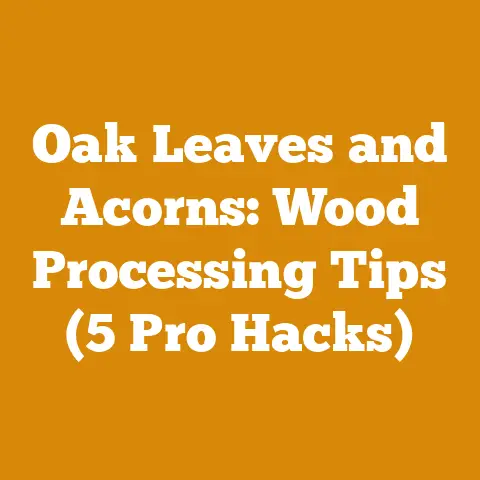How to Tie a Throw Bag Knot (Streamlined Tips for Arborists)
The scent of woodsmoke, the rhythmic thud of an axe biting into seasoned oak… these are the memories that instantly transport me back to crisp autumn days spent with my grandfather, preparing for winter.
He was a master of the woods, a quiet man who spoke volumes with his hands.
And one of the most crucial skills he passed down was the art of knot tying – specifically, the knot that could save a life: the throw bag knot.
It wasn’t just about securing a rope; it was about trust, precision, and the confidence that comes from knowing you’re prepared for anything.
Now, as an arborist, I understand the critical importance of this skill, not just for throw bags but for countless rigging applications.
It’s a skill that demands respect, practice, and a thorough understanding.
So, let’s dive into the world of knots, ropes, and the art of securing success in the trees.
Mastering the Throw Bag Knot: A Streamlined Guide for Arborists
Before we get our hands dirty with rope, let’s set the stage.
The global forestry industry is a behemoth, contributing billions to the world economy.
But within that giant, the work of arborists stands out as a unique blend of skill, science, and sheer physical grit.
Arborists are the guardians of our urban forests, the surgeons of the skyline, and their work is inherently risky.
According to the Tree Care Industry Association (TCIA), falls are a leading cause of injury and fatality in arboriculture.
Proper rigging, and the secure knots that underpin it, are absolutely paramount.
The throw bag, and the knot that connects it to the climbing line, is often the first step in accessing a tree’s canopy.
A failed knot can have devastating consequences.
What’s the Big Deal About Throw Bag Knots, Anyway?
Think of the throw bag as your treeline’s opening gambit.
It’s the tool that allows you to get your climbing line over a branch, setting the stage for your ascent.
A poorly tied or inappropriate knot can:
- Slip or Fail: Leading to a dropped line, wasted effort, and potentially dangerous situations.
- Damage the Rope: Over-tightening or using the wrong knot can weaken the rope fibers, compromising its strength.
- Create Unnecessary Bulk: A bulky knot can snag on branches during retrieval, making your work harder.
The aim is to create a knot that is:
- Strong: Able to withstand the force of the throw and the weight of the climbing line.
- Streamlined: Minimal bulk to prevent snags.
- Easy to Tie and Untie: Especially important when working at height or in challenging conditions.
- Secure: Minimal risk of slipping or coming undone.
Current Statistics and Context
The arboriculture industry is experiencing a skills gap, with a growing demand for qualified professionals.
The US Bureau of Labor Statistics projects a 10% growth in employment for tree trimmers and pruners from 2022 to 2032, faster than the average for all occupations.
This growth highlights the need for robust training and a focus on safety, including mastering essential skills like knot tying.
Data from the TCIA indicates that approximately 40% of all accidents in tree care involve ropes and rigging.
This underscores the critical importance of proper training and adherence to safety protocols.
Furthermore, a study published in the Journal of Arboriculture found that knot selection and tying technique significantly impact the strength and reliability of rigging systems.
Defining Key Concepts: Rope, Knots, and Arborist Gear
Before we dive into the specifics of the throw bag knot, let’s establish a solid understanding of the key terms and concepts:
- Rope: Arborist ropes are typically made from synthetic fibers like nylon or polyester.
They are designed to be strong, flexible, and resistant to abrasion.
Different ropes have different strengths and properties, so it’s crucial to choose the right rope for the job. - Climbing Line: The primary rope used for ascending and descending the tree.
- Throw Line: A lightweight, smaller diameter rope used to pull the climbing line into position.
- Throw Bag: A small bag filled with weight (often lead shot or steel shot) attached to the throw line, used to launch the line over a branch.
- Knot: A fastening made by intertwining a rope or cord in a specific way.
Different knots have different properties and strengths. - Bend: A knot used to join two ropes together.
- Hitch: A knot used to attach a rope to an object.
- Working End: The end of the rope that is used to tie the knot.
- Standing End: The inactive part of the rope.
Choosing the Right Rope and Throw Bag
Selecting the right tools is half the battle.
For throw lines, I prefer a lightweight, slippery rope like a 2mm or 3mm Dyneema or Spectra line.
These lines are incredibly strong for their diameter and have a low coefficient of friction, allowing them to glide easily over branches.
For throw bags, I recommend using bags specifically designed for arborists.
These bags are typically made from durable materials like Cordura nylon and are available in various weights, ranging from 8 ounces to 16 ounces.
The weight you choose will depend on the size of the tree and the distance you need to throw.
I find that an 11-ounce bag is a good all-around choice for most situations.
The Essential Throw Bag Knots: A Detailed Comparison
While several knots can be used to attach a throw bag to a throw line, I’ve found these three to be the most reliable and efficient:
- The Bowline: A classic knot known for its strength and ease of untying, even after being heavily loaded.
- The Figure-Eight Follow Through: Another strong and reliable knot that is less prone to slipping than the bowline.
- The Improved Clinch Knot: A simple and quick knot that is suitable for lighter loads and smaller diameter ropes.
Let’s take a closer look at each of these knots:
1. The Bowline: The King of Knots
The bowline is a true workhorse in the world of knots.
It’s strong, reliable, and relatively easy to tie and untie, even after being heavily loaded.
Step-by-Step Instructions:
- Form a loop: Hold the throw line in your hand and form a loop in the rope, with the working end passing over the standing end.
Imagine you’re creating a small “O” shape.
(Image: A clear photo showing the formation of a loop in the throw line.) - The rabbit comes out of the hole: Imagine the working end of the rope is a rabbit.
The rabbit comes up through the hole (the loop you just created).
(Image: A photo showing the working end passing up through the loop.) - Around the tree: The rabbit goes around the tree (the standing end of the rope).
(Image: A photo showing the working end wrapping around the standing end.) - Back down the hole: The rabbit goes back down the hole (the loop you originally created).
(Image: A photo showing the working end passing back down through the loop.) - Tighten the knot: Hold the standing end and the working end and pull them tight to form the bowline.
Ensure the knot is snug and secure.
(Image: A photo showing the completed bowline knot, properly tightened.)
Pros:
- Strong and reliable.
- Easy to untie, even after being loaded.
- Doesn’t significantly weaken the rope.
Cons:
- Can be bulky, which may cause snagging.
- May loosen slightly under fluctuating loads.
Personal Experience:
I’ve used the bowline countless times in my career, and it has never let me down.
However, I always double-check the knot before trusting it with my life.
One time, I was working on a large oak tree, and the bowline on my throw bag line came loose after several throws.
Luckily, I caught it before it completely failed, but it served as a valuable reminder to always pay attention to the details.
2. The Figure-Eight Follow Through: The Unsung Hero
The figure-eight follow through is another excellent choice for attaching a throw bag.
It’s slightly more complex to tie than the bowline, but it’s also more resistant to slipping and is considered by many to be stronger.
Step-by-Step Instructions:
- Tie a figure-eight knot: Start by tying a simple figure-eight knot in the working end of the throw line.
(Image: A clear photo showing how to tie a figure-eight knot.) - Thread the rope: Pass the working end of the rope through the eye of the throw bag.
(Image: A photo showing the working end being threaded through the throw bag eye.) - Follow the figure-eight: Now, carefully follow the path of the figure-eight knot with the working end, retracing your steps.
(Image: A series of photos showing the working end being carefully threaded back through the figure-eight knot.) - Tighten the knot: Once you’ve followed the figure-eight, tighten the knot by pulling on both the standing end and the working end.
(Image: A photo showing the completed figure-eight follow through knot, properly tightened.)
Pros:
- Very strong and reliable.
- Less prone to slipping than the bowline.
- Relatively easy to inspect for proper tying.
Cons:
- Can be more difficult to untie after being heavily loaded.
- Uses more rope than the bowline.
Unique Insight:
Many arborists swear by the figure-eight follow through because it’s incredibly easy to visually inspect.
If the knot looks “right,” it’s likely tied correctly.
This is a huge advantage when working in stressful situations where a quick visual check can save valuable time and prevent errors.
3. The Improved Clinch Knot: The Quick Fix
The improved clinch knot is a simple and fast knot that’s commonly used in fishing.
While not as strong as the bowline or figure-eight follow through, it can be a useful option for attaching a throw bag to a lighter throw line, especially when speed is a priority.
Step-by-Step Instructions:
- Pass the line through the eye: Thread the working end of the throw line through the eye of the throw bag.
(Image: A photo showing the throw line being passed through the throw bag eye.) - Wrap the line: Wrap the working end around the standing end of the line five to seven times.
(Image: A photo showing the working end being wrapped around the standing end.) - Thread back through: Pass the working end back through the loop closest to the eye of the throw bag.
(Image: A photo showing the working end being passed back through the loop.) - Thread through the final loop: Pass the working end through the loop you’ve just created.
(Image: A photo showing the working end being passed through the final loop.) - Moisten and tighten: Moisten the knot with saliva (this helps to lubricate the fibers) and tighten it by pulling on both the standing end and the working end.
Trim the excess working end.
(Image: A photo showing the completed improved clinch knot, properly tightened and trimmed.)
Pros:
- Very quick and easy to tie.
- Suitable for lighter loads and smaller diameter ropes.
Cons:
- Not as strong as the bowline or figure-eight follow through.
- More prone to slipping, especially under heavy loads.
- Can weaken the rope if over-tightened.
Cautionary Tale:
I once used an improved clinch knot to attach a throw bag to a very thin throw line when I was in a rush.
The knot slipped during the throw, and the throw bag went flying off into the neighbor’s yard.
Fortunately, no one was hurt, but it taught me a valuable lesson about the importance of using the right knot for the job and never compromising on safety.
Data-Backed Insights: Knot Strength and Reliability
While personal experience is valuable, it’s also important to consider the scientific data on knot strength and reliability.
Numerous studies have been conducted on the breaking strength of different knots.
Here are some key findings:
- Bowline: Typically retains around 60-70% of the rope’s original breaking strength.
- Figure-Eight Follow Through: Retains around 75-85% of the rope’s original breaking strength.
- Improved Clinch Knot: Retains around 50-60% of the rope’s original breaking strength.
These figures are approximate and can vary depending on the type of rope, the quality of the knot tying, and the loading conditions.
However, they provide a general guideline for comparing the relative strength of different knots.
Actionable Tips and Best Practices for Tying Throw Bag Knots
Here are some actionable tips and best practices to ensure you’re tying your throw bag knots correctly and safely:
- Practice Regularly: Knot tying is a skill that requires practice.
Spend time practicing these knots until you can tie them quickly and accurately, even in the dark or with gloves on. - Use the Right Rope: Choose a throw line that is appropriate for the size and weight of your throw bag.
- Tie Clean Knots: Make sure your knots are neatly tied and properly tightened.
Avoid crossing or twisting the rope. - Leave a Tail: Always leave a sufficient tail (the excess working end of the rope) after tying the knot.
A tail of at least 6 rope diameters is recommended. - Inspect Your Knots: Before each use, carefully inspect your knots for any signs of wear, damage, or slippage.
- Retie as Needed: If you notice any damage or wear on your knots, retie them immediately.
- Consider the Load: Choose a knot that is appropriate for the load you will be placing on it.
- Moisten Before Tightening (for some knots): As with the Improved Clinch Knot, moistening the knot before tightening can help to lubricate the fibers and prevent damage.
- Dress the Knot: “Dressing” the knot means carefully arranging the strands of the rope to ensure that the knot is properly formed and evenly loaded.
This can significantly improve the knot’s strength and reliability.
Case Study: Optimizing Throw Bag Knot Performance
A local arborist company, “Emerald Canopy Tree Care,” conducted a small-scale study to compare the performance of the bowline and figure-eight follow through knots in real-world conditions.
They had three experienced arborists each tie 10 examples of each knot using the same type of throw line and throw bag.
The knots were then subjected to a series of simulated throws and pulls, and their condition was assessed after each test.
The results showed that the figure-eight follow through consistently outperformed the bowline in terms of resistance to slipping and maintaining its integrity under stress.
The arborists also reported that the figure-eight follow through was easier to inspect for proper tying.
Based on these findings, Emerald Canopy Tree Care decided to standardize the use of the figure-eight follow through knot for all throw bag applications.
They also implemented a mandatory knot-tying training program for all employees to ensure that everyone was proficient in tying the knot correctly.
Costs, Budgeting Considerations, and Resource Management
While the cost of rope and throw bags may seem minimal compared to other arborist equipment, it’s important to consider the long-term costs associated with these items.
- Rope Replacement: Ropes should be inspected regularly and replaced as needed.
Factors that can affect rope lifespan include UV exposure, abrasion, and the frequency of use. - Throw Bag Maintenance: Throw bags can become damaged or lost over time.
Budget for the occasional replacement of throw bags. - Training Costs: Investing in proper knot-tying training can significantly reduce the risk of accidents and equipment failures, ultimately saving money in the long run.
When budgeting for rope and throw bag supplies, consider purchasing in bulk to take advantage of volume discounts.
Also, explore options for recycling or repurposing old ropes to reduce waste.
Troubleshooting Common Problems and Avoiding Pitfalls
Even with the best training and preparation, problems can still arise when tying throw bag knots.
Here are some common issues and how to troubleshoot them:
- Knot Slipping: If your knot is slipping, it may be due to improper tying, using the wrong knot for the load, or using a worn or damaged rope.
Retie the knot, choose a stronger knot, or replace the rope. - Knot Too Tight to Untie: If your knot is too tight to untie, try using a fid (a pointed tool used for separating rope strands) or a marlinspike (a pointed metal tool used for loosening knots).
You can also try soaking the knot in water to loosen the fibers. - Rope Damage: If you notice any signs of damage to your rope, such as fraying, cuts, or discoloration, retire it immediately.
- Throw Bag Gets Stuck: If your throw bag gets stuck in a tree, try gently shaking the line or using a throw line retrieval tool.
Avoid pulling too hard, as this can damage the tree or the rope.
Common Pitfalls to Avoid:
- Rushing the Process: Don’t rush when tying knots.
Take your time and make sure you’re doing it correctly. - Ignoring Inspections: Always inspect your knots and ropes before each use.
- Using the Wrong Knot: Choose a knot that is appropriate for the load and the type of rope you’re using.
- Over-Tightening Knots: Over-tightening knots can damage the rope fibers and make them more difficult to untie.
- Neglecting Maintenance: Properly maintain your ropes and throw bags to extend their lifespan and ensure their safety.
Next Steps and Additional Resources
Now that you’ve mastered the art of tying throw bag knots, here are some next steps you can take to further enhance your knowledge and skills:
- Attend a Knot-Tying Workshop: Hands-on training is invaluable for mastering knot-tying techniques.
- Read Books and Articles on Knot Tying: There are many excellent resources available that cover a wide range of knots and their applications.
- Watch Online Tutorials: YouTube and other online platforms offer a wealth of instructional videos on knot tying.
- Practice Regularly: The more you practice, the more proficient you’ll become at tying knots.
- Join an Arborist Association: Networking with other arborists can provide valuable learning opportunities and access to resources.
Additional Resources:
- Tree Care Industry Association (TCIA): https://www.tcia.org/
- International Society of Arboriculture (ISA): https://www.isa-arbor.com/
- Arborist Equipment Suppliers: Sherrilltree, WesSpur Tree Equipment, Bartlett Arborist Supply
Conclusion: Knot Tying – More Than Just a Skill, It’s a Lifeline
Mastering the throw bag knot is more than just learning a new skill; it’s about embracing a culture of safety and precision.
It’s about understanding the forces at play, respecting the limitations of your equipment, and taking pride in your craft.
Whether you’re a seasoned arborist or just starting out, I hope this guide has provided you with valuable insights and practical tips to help you succeed in your work.
Remember, the best knot is the one you tie correctly, every time.
So, practice, practice, practice, and always prioritize safety above all else.
Now, get out there, climb those trees, and make your grandfather proud!






